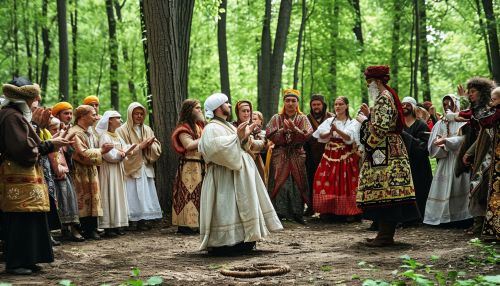Slavic paganism
Historical Overview
Slavic paganism, also known as Slavic religion, refers to the religious beliefs, myths, and ritual practices of the Slavs before the formal Christianisation of their ruling elites. The latter occurred at various stages between the 8th and the 13th century: The South Slavs living on the Balkan Peninsula in South Eastern Europe, bordering with the Byzantine Empire to the south, became Christianised the earliest, by the 9th century. The West Slavs, who inhabited the lands between the Vistula and the Elbe in Northern Europe, became Christianised through the efforts of the Holy Roman Empire and the Kingdom of Poland in the 10th century. Finally, the East Slavs, located in Eastern Europe between the Dnieper and the Volga rivers, followed suit in the 10th and the 13th century, respectively, under the influence of the Byzantine Empire and the Mongol invasion.


Beliefs and Deities
The pantheon of Slavic gods varies according to region and historical period. However, there are certain deities that were worshipped widely across the Slavic world. The supreme god was often associated with heavenly phenomena, thunder, and the law and order of the universe. In the East Slavic tradition, this god was known as Perun, while in the West Slavic tradition, he was called Perun or Svarog. The god of fertility and wealth, known as Veles, was also widely worshipped. Other important deities included the goddess of love and beauty Lada, the god of the underworld Morena, and the god of war Triglav.
Rituals and Practices
Rituals in Slavic paganism were an integral part of daily life and were often tied to agricultural cycles. They included various rites of passage, seasonal rituals, and ceremonies related to birth, marriage, death, and harvest. One of the most important rituals was the annual celebration of the winter solstice, known as Koliada. During this festival, people would sing carols, perform plays, and participate in processions.
Legacy and Revival
Despite the Christianisation of the Slavs, many elements of Slavic paganism have survived to the present day. These include folk customs, traditions, and superstitions, as well as certain aspects of Slavic folklore, such as fairy tales, legends, and epic songs. In recent decades, there has been a revival of interest in Slavic paganism, with new religious movements such as Rodnovery seeking to reconstruct and revive the ancient Slavic religion.
